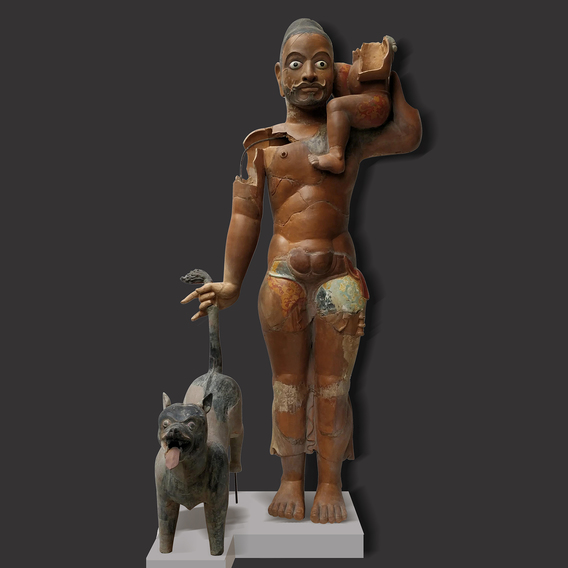-
From Current Issue
-
- Editor’s Letter Fire in the Heart
- Reviews I Gusti Ayu Kadek Murniasih
- Reviews 11th Seoul Mediacity Biennale: “One Escape at a Time”
- Dispatch Networked China
- One on One Monira Al Qadiri on Yukio Mishima
- Essays The rise of independent art spaces in pandemic-era Shanghai
- Features Tuan Andrew Nguyen
- Table of Contents
- Web Exclusives
- Archive
- Subscribe

R
E
V N
E
X
T
Installation view of MANJUNATH KAMATH’s “Era Elsewhere” at Gallery Espace, New Delhi, 2019. All images courtesy Gallery Espace.
As much as our sense of history is a question of content—what happened and when—it is also sensitive to form. In the example of text, from which we extract so much knowledge of the past 4,000 or so years, typeface, binding and paper can carry as much information as words themselves. And when it comes to physical objects that bear no writing, form is everything. For this reason, visual art has just as much potential to explore the world we live in by using anti-historical narratives as the post-modern novel does. In the case of the new works by Manjunath Kamath exhibited in “Era Elsewhere” at New Delhi’s Gallery Espace, much attention has been paid to form, but less to narrative.
The sculptural works in the exhibition are mostly made from painted terracotta, a medium with roots in South Asia dating back to the bronze age. However, when looking at one of these sculptures, it doesn’t take long for flashes of alternative aesthetics, places and styles to shine through. The wide-eyed facial expression and mustachioed features of the main figure in Shwanapani (2019) are of the kind you might see among the statues in Delhi Sanskriti Museum of Indian Terracotta. But his upright posture faintly recalls the famous Terracotta Warriors after which the material is probably best known, and the canine companion by his side has much akin with certain depictions of dogs in Han Dynasty statuary. Here, but more prominently in other works such as Unfolding Moon (2019), the sporadic use of color also references a variety of sources. In this latter work, saucer-shaped and around two meters in diameter, an assortment of geometric patterns gives the effect of a fragmented mandala. But on closer inspection, some of the sections, particularly the painted ones, clearly recall the blue and white decagonal patterns found in Islamic art across the Arab world. The mixture of cultures—and it is a mixture rather than a clash—extends even further with glazed fragments whose blue and white floral decorations mark the influence of Chinese porcelain production on the former Ottoman empire, and indeed much of the world.
Besides the statues, Kamath also included a selection of gouaches on silk, among them Behind the Clouds and Ritual Drawings (both 2019), which recall in part the miniature tradition of Mughal painters but also, in the sparse compositions and amount of silk left unpainted, Japanese nihonga painting. What these and the sculptural works have in common is that they have all been made to appear aged, and in many cases even damaged. In the pictures, areas are often faded, while sections of the sculptures are frequently cracked or missing. The most striking example of this is in To Be Continued… (2019), where the body of a horse merges with a standing figure that faces it, with one foot raised to the animal’s chest. The heads of both figures are missing, and from them a cubistic wirework frame emerges that is incongruously, though not unattractively, modernist.
This meticulously crafted combination of artifice and apocrypha is visually striking, and the process of recognizing the various sources alluded to in each work is intellectually rewarding, but just what we are meant to garner from this “era elsewhere” is elusive. The impression arises that these works might have some utopian intention, a kind of aesthetic multicultural endgame, but what this says about the interactions between these aesthetics, and the cultures to which they belong, is unclear. It is possible, and no doubt valid, that the works could be seen as a simple experiment in mixing forms, but when the religious, social and geographical implications behind these forms are so significant, this feels insufficient. The art-object-as-false-artifact has huge potential for historiographical comment. Larissa Sansour’s burying in Israel of china plates ostensibly manufactured by an extinct civilization for her 2015 film, In the Future they Ate From the Finest Porcelain, is a fine example. While Kamath’s objects are often well made and attractive in form, they lack the sense of a narrative that would make them truly believable.
Ned Carter Miles is the London desk editor of ArtAsiaPacific.
Manjunath Kamath’s “Era Elsewhere” is on view at Gallery Espace, New Delhi, until March 2nd, 2019.
To read more ofArtAsiaPacific’s articles, visit our Digital Library.



















